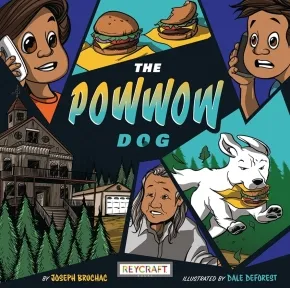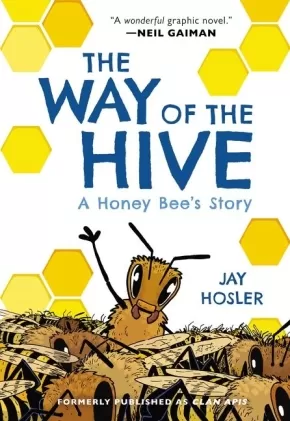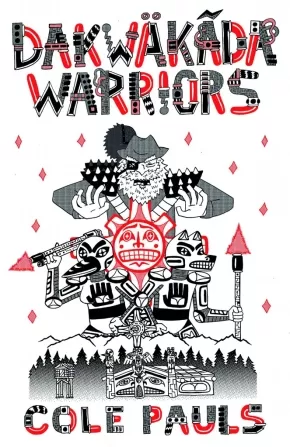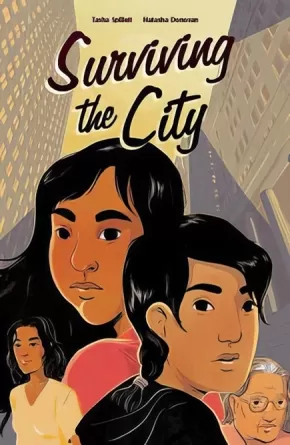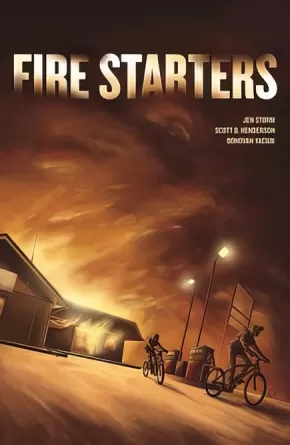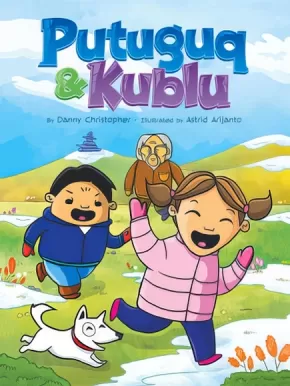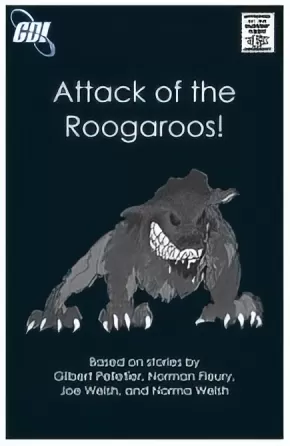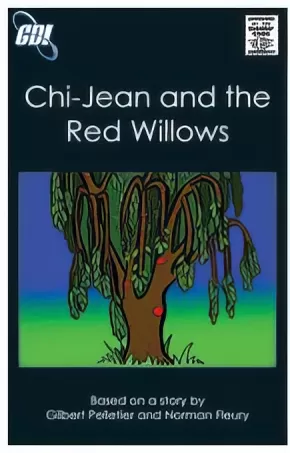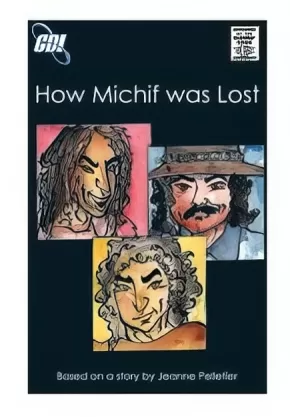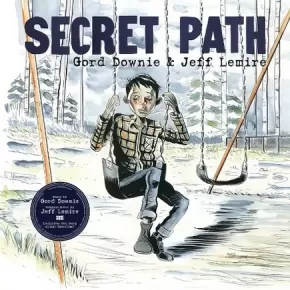
Graphic Novels
31
-
45
of
59 Results;
Sort By
Go To
of 4
The Powwow Dog
$13.45
Artists:
Format:
Paperback
Text Content Territories:
Indigenous American;
ISBN / Barcode: 9781478869016
Synopsis:
Synopsis:
When Jamie and Marie Longbow find out about the mysterious ghost dog that steals food from the Powwow and no one has been able to catch, they are determined to find out what's going on. When they finally get closer to it, it runs into the spooky abandoned house, with a buffalo burger dangling from its mouth, where Old Man Jimmerson used to live. Is it really a ghost dog? Should they go in? How are they going to solve this mystery when they are terrified of what might be on the other side of the door?
Reviews
"The second book in a mystery series features a dog who swipes buffalo burgers from the Seneca Chef’s stand at the powwow. Marie and Jamie, twin siblings, come to the event with their grandparents. They pass an old house on the edge of the reservation and the stage is set for the unfolding of the mystery. Bruchac, a storyteller and Abenaki author, tells a gentle story about the strong relationships between grandparents and children, the inviting atmosphere of the powwow grounds, and the mystery-solving ability of children. Deforest’s colorful illustrations convey the feelings the characters experience: joy, excitement, fear, sadness, and relief. Marie, Jamie, and their grandparents are Native, but their specific nation is not revealed. The book is divided into short chapters, creating a sort of picture book/graphic novel hybrid, which should appeal to emerging and/or reluctant readers. VERDICT An accessible and fun story that introduces young readers to Native culture, recommended for elementary and homeschool collections."—School Library Journal Reviewer
"Abenaki author Bruchac collaborates with illustrator Deforest, who uses his experiences growing up in Navajo country to create bold and colorful comic-book–style illustrations of this contemporary Native American family and a diverse, happy gathering of powwow attendees... Happily, there are more powwow adventures to come." - Kirkus Reviews
Educator & Series Information
Recommended for grades 2 to 5.
This book is part of the Powwow Mystery series.
Additional Information
32 pages | 9.80" x 9.80"
The Way of the Hive: A Honey Bee's Story
$17.50
Artists:
Format:
Paperback
ISBN / Barcode: 9780063007352
Synopsis:
Synopsis:
Experience the life of a honeybee in this coming-of-age story about a bee named Nyuki, in this full-color graphic novel by Jay Hosler, perfect for curious kids who are fans of the Science Comics series.
Nyuki is a brand-new honeybee—and she has a lot of questions. Like
- When does a bee go through metamorphosis?
- Why does a queen bee sometimes leave her hive?
- And where does all this honey come from, anyway?!
But Nyuki’s biggest question is, “What is this inner voice I hear, and why does it tell me to go forth to adventure?
Follow Nyuki on a lifelong journey as she annoys her sisters, avoids predators, and learns to trust her inner voice as she masters the way of the hive.
And if you still have questions at the end, the back of the book uncovers even more mysteries about the lives of these incredible insects!
Reviews
"A truly lovely coming-of-age tale buzzing with bee facts, this is a honey pot for budding entomologists, naturalists, and scientists of all variety." — Booklist
"Graphic novel fans, lovers of nonfiction, budding ecologists, and readers looking for their next great obsession will be buzzing around this title for years to come." — Kirkus Reviews (starred review)
Educator Information
Recommended for ages 8 to 12.
Additional Information
160 pages | 5.50" x 8.00"
Dakwäkãda Warriors
$20.00
Artists:
Format:
Paperback
Text Content Territories:
Indigenous Canadian; First Nations; Dene; Tahltan (Nahanni);
ISBN / Barcode: 9781772620412
Synopsis:
Synopsis:
Indigenous protectors use language revitalization to save the Earth from evil pioneers and cyborg sasquatches.
Ts’ür’i and Aghay are the Dakwäkãda Warriors protecting Nän from their nemesis Cyber Nà’į and Space Kwäday Dän. Flying in their spaceship, can they prevent the Sha being stolen from Cyber Nà’į and Space Kwäday Dän?!
As a young person growing up in Haines Junction YT, artist Cole Pauls performed in a traditional song and dance group called the Dakwäkãda Dancers. During that time, Pauls encountered the ancestral language of Southern Tutchone. Driven by a desire to help revitalize the language, he created Dakwäkãda Warriors, a bilingual comic about two earth protectors saving the world from evil pioneers and cyborg sasquatches.
Pauls’ Elders supported him throughout the creation process by offering consultation and translation. The resulting work is a whimsical young adult graphic novel that offers an accessible allegory of colonialism. Dakwäkãda Warriors also includes a behind-the-scenes view into the making of the comic and a full-colour insert featuring character illustrations by guest Indigenous Canadian artists.
Awards
- 2020 Indigenous Voices Awards Winner for Works in an Indigenous Language
Reviews
From the publisher, an interview with Cole Pauls:
1. Why did you decide to create this comic?
I wanted to create a sense of identity and strength for the youth from my hometown and the Yukon. To be portrayed in a heroic but also realistic way, where culture is power and the community is stronger because of that. I made Dakwäkãda Warriors to keep Southern Tutchone language and culture alive.
2. What do you hope your work will bring to the Canadian comics canon?
A proper portrayal of Yukon Indigenous culture, we don't live in igloos, ya know!! I want to show the world what Southern Tutchone culture really is and how strong Indigenous culture can be when properly portrayed by someone who lives and practices it.
Educator Information
Recommended Ages: 8 to 16
Language revitalization in an allegory of colonialization.
Artist Cole Pauls wanted to reclaim the Southern Tutchone language he had learned as a youth while performing in a traditional song and dance group. So, he created a comic about two Earth Protectors saving the Earth from evil pioneers and cyborg sasquatches. But he also went to his elders and asked them to translate his comic into the two dialects of Southern Tutchone. The resulting work is an allegory of colonialization done in an accessible format, a whimsical young adult graphic novel which helps to revitalize language. Pauls includes a "making of" postscript to give context to the project, and invites guest Indigenous Canadian artists to provide "pin-ups" of his characters.
Additional Information
112 pages | 6.50" x 10.00" | 112 illustrations
The Powwow Thief
$13.45
Artists:
Format:
Paperback
Text Content Territories:
Indigenous American;
ISBN / Barcode: 9781478868965
Synopsis:
Synopsis:
Twins Jamie and Marie Longbow are excited about summer with their grandparents, traveling from powwow to powwow selling goods they helped make. When their grandmother's most beautiful necklace goes missing, it's up to the twins to solve the mystery.
Reviews
"Marie Longbow and her twin brother Jamie accompany their grandparents to a powwow to sell jewelry and regalia. After the family returns from participating in the Friendship dance, they find that Grama’s best piece of jewelry is missing. Using both brains and brawn, the twins track down a surprising thief. The cartoonish drawings have a pop art feel with bright colors, and comic panels are incorporated into the single- and double-page illustrations. A variety of regalia is depicted on the dancers and drummers. Speech bubbles are used for some of the text to emphasis parts of the conversations. Native American terms are sprinkled into the narrative along with descriptions of powwow activities. The book is divided into short chapters, creating a sort of picture book/graphic novel hybrid, which should appeal to emerging and/or reluctant readers. VERDICT This beginning mystery with a Native American focus is a good general purchase, and creates a useful transition from picture books to chapter books or graphic novels for younger readers." —School Library Journal Reviewer
"This early chapter book with a picture book trim size, the first installment of the Powwow Mystery Series, features twins Jamie and Marie Longbow, who are traveling to powwows this summer with their grandparents to sell Grama’s wares. Jamie excels at tree climbing, while Marie loves to read and memorize facts about birds. When Grama’s best necklace is stolen at the Little Eagle powwow grounds, the first powwow they visit, it’s up to the twins and their respective talents to help solve the case. Bruchac (Brothers of the Buffalo), an enrolled member of the Nulhegan Bank of the Abenaki nation, offers a well-paced introduction of the characters and elements of the powwow over the four chapters. While the foreshadowing may be a bit transparent (“ ‘It’s okay,’ Grampa said as he danced past them. ‘Sleepy Mickey is watching the booth.’ ”), the identity of the thief and the resolution still prove satisfying. Deforest, who was raised on the Navajo reservation in New Mexico, contributes boldly outlined and brightly colored digital illustrations in an accessible comic-book style that will likely entice reluctant readers."—Publishers Weekly
Educator & Series Information
Recommended for grades 2 to 5.
This book is part of the Powwow Mystery series.
Additional Information
|
Pemmican Wars
$21.95
Artists:
Format:
Paperback
Text Content Territories:
Indigenous Canadian; Métis;
ISBN / Barcode: 9781553796787
Synopsis:
Synopsis:
Echo Desjardins, a 13-year-old Métis girl adjusting to a new home and school, is struggling with loneliness while separated from her mother. Then an ordinary day in Mr. Bee’s history class turns extraordinary, and Echo’s life will never be the same. During Mr. Bee’s lecture, Echo finds herself transported to another time and place—a bison hunt on the Saskatchewan prairie—and back again to the present. In the following weeks, Echo slips back and forth in time. She visits a Métis camp, travels the old fur-trade routes, and experiences the perilous and bygone era of the Pemmican Wars.
Educator & Series Information
Recommended for ages 12+ by the publisher.
Pemmican Wars is the first graphic novel in the A Girl Called Echo series.
Books in this series include:
Volume 1: Pemmican Wars
Volume 2: Red River Resistance
Volume 3: Northwest Resistance
Volume 4: Road Allowance Era
The Canadian Indigenous Books for School list recommends this for Grades 5-12 for these subject areas: Arts Education, English Language Arts, Social Studies.
This book is available in French: Elle s'appelle Echo Tome 1: La guerre du Pemmican
Additional Information
48 pages | 6.50" x 10.00"
Putuguq & Kublu and the Qalupalik
$9.95
Artists:
Format:
Paperback
Text Content Territories:
Indigenous Canadian; Inuit;
ISBN / Barcode: 9781772272284
Synopsis:
Synopsis:
What creatures lurk beneath the sea ice? Putuguq and Kublu – two siblings who can’t seem to get along- are about to find out! On their way to the shoreline, Putuguq and Kublu run into their grandfather, who has a stern warning for the pair: always beware when playing on the shore, because you never know if a qalupalik, a mythical creature that snatches children, is lying in wait under the ice. Kublu is pretty sure their grandfather is just trying to spook them with a scary story from the past….but maybe not?
Reviews
"More playful than scary, Putuguq & Kublu and the Qalupalik! succeeds in teaching about contemporary Indigenous culture in a non-didactic, humorous way. As a supplementary text, it will easily align to curricula while helping children build their literacy skills. With brightly coloured illustrations and engaging dialogue, it’s one of those books that is highly informational without revealing as much to its young readers."
"This graphic novel for beginners has just the right balance of mischief, excitement, and danger, with enough humor to keep things light. Bright colors, clean lines, and larger panels make for inviting, uncluttered reading. Set in a small town in Nunavut, Canada, this story centers Inuit culture in all aspects but never feels forced or didactic. Rather, readers will get a glimpse into contemporary Indigenous lives that are both different and very much like their own."
Educator & Series Information
This book is part of the Putuguq & Kublu series.
Recommended for ages 5+
Additional Information
32 pages | 6.00" x 8.00"
Red River Resistance
$21.95
Artists:
Format:
Paperback
Text Content Territories:
Indigenous Canadian; Métis;
ISBN / Barcode: 9781553797470
Synopsis:
Synopsis:
Echo Desjardins is adjusting to her new home, finding friends, and learning about Métis history. She just can’t stop slipping back and forth in time. One ordinary afternoon in class, Echo finds herself transported to the banks of the Red River in the summer of 1869. All is not well in the territory as Canadian surveyors have arrived to change the face of territory, and Métis families, who have lived there for generations, are losing access to their land. As the Resistance takes hold, Echo fears for her friends and the future of her people in the Red River Valley.
Educator & Series Information
Recommended for grades 5 to 9.
Red River Resistance is volume two in the graphic novel series, A Girl Called Echo, by Katherena Vermette.
Books in this series include:
Volume 1: Pemmican Wars
Volume 2: Red River Resistance
Volume 3: Northwest Resistance
Volume 4: Road Allowance Era
Recommended in the Canadian Indigenous Books for Schools 2019-2020 resource list as being useful for grades 5-12 with regard to these subjects: English Language Arts, Art Education, Social Studies.
This book is available in French: Elle s'appelle Echo Tome 2: La guerre du Pemmican
Additional Information
47 pages | 6.50" x 10.00"
Surviving the City Vol. 1
$21.95
Artists:
Format:
Paperback
Text Content Territories:
Indigenous Canadian; First Nations; Cree (Nehiyawak); Anishinaabeg;
ISBN / Barcode: 9781553797562
Synopsis:
Synopsis:
Tasha Spillett’s graphic novel debut, Surviving the City, is a story about womanhood, friendship, colonialism, and the anguish of a missing loved one.
Miikwan and Dez are best friends. Miikwan is Anishinaabe; Dez is Inninew. Together, the teens navigate the challenges of growing up in an urban landscape – they’re so close, they even completed their Berry Fast together. However, when Dez’s grandmother becomes too sick, Dez is told she can’t stay with her anymore. With the threat of a group home looming, Dez can’t bring herself to go home and disappears. Miikwan is devastated, and the wound of her missing mother resurfaces. Will Dez’s community find her before it’s too late? Will Miikwan be able to cope if they don’t?
Awards
- Winner of the 2019 Indigenous Voices Award for Works in an Alternative Format
- Co-winner of the Eileen McTavish Sykes Award for Best First Book by a Manitoba Author
- Winner of the Manuela Dias Design and Illustration Award, Graphic Novel category
Educator & Series Information
Recommended Grades: 7-12.
This graphic novel is part of the Surviving the City series, which is also part of the Debwe Series.
The Surviving the City series includes these titles:
- Surviving the City
- From the Roots Up
- We Are the Medicine
Recommended in the Canadian Indigenous Books for Schools 2019-2020 resource list for grades 10 to 12 for English Language Arts and Social Studies.
This book could be triggering for some readers as it contains mature content and focuses on issues such as Missing and Murdered Indigenous Women and Girls.
A Teacher Guide is available: Surviving the City Teacher Guide: Exploring Identity, Allyship, and Social Action for Meaningful Change in Grades 7-12
Additional Information
56 pages | 6.50" x 10.00"
The Fox Wife
$16.95
Artists:
Format:
Hardcover
Text Content Territories:
Indigenous Canadian; Inuit;
ISBN / Barcode: 9781772272123
Synopsis:
Synopsis:
On a cloudless summer night, a fox falls to earth and comes across a family of humans. As the seasons change and they move their camp, she follows them, growing ever more intrigued by human ways—and especially by the oldest son, Irniq.
When Irniq grows older and sets out hunting on his own, he is surprised to enter his tent one day and find the lamp lit, the tea made… and a strange woman who says she is his wife. Tired of being alone, Irniq welcomes the woman. But soon he grows curious and cannot stop himself from asking too many questions. Where did the fox pelt hanging in their tent come from? And why did the fox that had been following him suddenly disappear?
Based on award-winning musician Beatrice Deer’s powerful song “Fox,” this graphic novel reinterprets a traditional Inuit story for a new generation.
Educator Information
Recommended Ages: 7-9.
Format: Graphic Novel
This book is available in French: La Femme-renard
Additional Information
30 pages | 9.00" x 7.50"
Fire Starters
$18.95
Artists:
Format:
Paperback
Text Content Territories:
Indigenous Canadian; First Nations;
ISBN / Barcode: 9781553796855
Synopsis:
Synopsis:
Looking for a little mischief after finding an old flare gun, Ron and Ben suddenly find themselves in trouble when the local gas bar on Agamiing Reserve goes up in flames, and they are wrongly accused of arson by the sheriff’s son. As the investigation goes forward, community attitudes are revealed, and the truth slowly comes to light.
Reviews
"Storm's story is a very thoughtful look at the two systems of justice. The Native boys in the White system, being interrogated is a stark contrast to what the White boy experiences in the Native system of justice. It points to the path Storm is looking for: how a community can heal, rather than how it could punish and inflict more harm on people... I recommend Jen Storm's Fire Starters. There's a lot to study, think about, and of course, talk about." -- Debbie Reese, American Indians in Children's Literature
"Fire Starters reminds readers of the many perspectives involved in reconciliation. The story moves beyond Ron and Ben’s experiences as aboriginal teens poorly treated by a white community to include the experiences of law enforcement officers, family members, and even the arsonists themselves. Complementing the fast-paced plot, Henderson’s artwork is drawn from a wide variety of perspectives, and Yaciuk’s moody colours suit the rising tension experienced by all characters. A cautionary tale about the consequences of prejudice and racism, Fire Starters is a valuable addition to conversations about the importance of reconciliation and the power of the truth." -- Roseanne Gauthier, National Reading Campaign
Educator & Series Information
Recommended Grades: 6-9
Fire Starters is one book in The Debwe Series. This series features exceptional Indigenous writing from across Canada.
Putuguq & Kublu
$9.95
Artists:
Format:
Paperback
Text Content Territories:
Indigenous Canadian; Inuit;
ISBN / Barcode: 9781772271430
Synopsis:
Synopsis:
Putuguq and Kublu are a sister and brother who cannot get along. They love to pull pranks and one-up each other every chance they get! When one of Putuguq's pranks does not go as planned, the feuding siblings find themselves on the land with their grandfather, learning a bit about Inuit history, between throwing snowballs, that is.
Reviews
“An emotionally and spiritually warming visit to the Arctic.” — Kirkus Reviews
“Endnotes about inuksuit and the vanished Tuniit/Dorset people round out an entertaining story of sibling one-upmanship.” — Publisher’s Weekly
“. . . [A] fun romp across the tundra that will spark discussions about the Arctic, the Inuit and getting along with your siblings.” — CanLit for Little Canadians
Educator Information
This book is part of the Putuguq & Kublu series.
Recommended ages 5+
Additional Information
40 pages | 6.00" x 8.00" | Fully illustrated graphic novel
Attack of the Roogaroos!
$5.00
Artists:
Format:
Paperback
Text Content Territories:
Indigenous Canadian; Métis;
ISBN / Barcode: 9781926795775
Synopsis:
Synopsis:
This is the fifth book in the Stories of Our People series.
Educator & Series Information
Stories of Our People/Lii zistwayr di la naasyoon di Michif Series is a departure from other books about Aboriginal or traditional stories. It includes five stories. As readers go through the series, they will notice that the narrative and artwork gets progressively darker. The series starts with trickster stories, then moves to a Whiitigo and Paakuk story, then jumps to a story about selling one’s soul and personal redemption, and finally to a Roogaroo story.
This project came to life from the stories of our Elders, and as such, original transcripts of the stories, prose renditions by Janice DePeel, and biographies of the storytellers and project team are available on the Virtual Museum of Métis History and Culture: www.metismuseum.ca/browse/index.php?id=13100
Based on stories by Norman Fleury, Gilbert Pelletier, Jeanne Pelletier, Joe Welsh, and Norma Welsh.
Stories of Our People/Lii zistwayr di la naasyoon di Michif Series:
Book 1: How Michif was Lost
Book 2: Chi-Jean and the Red Willows
Book 3: Whistle for Protection
Book 4: Sins of the Righteous
Book 5: Attack of the Roogaroos!
Chi-Jean and the Red Willows
$5.00
Artists:
Format:
Paperback
Text Content Territories:
Indigenous Canadian; Métis;
ISBN / Barcode: 9781926795744
Synopsis:
Synopsis:
This is the second book in the Stories of Our People series.
Educator & Series Information
Stories of Our People/Lii zistwayr di la naasyoon di Michif Series is a departure from other books about Aboriginal or traditional stories. It includes five stories. As readers go through the series, they will notice that the narrative and artwork gets progressively darker. The series starts with trickster stories, then moves to a Whiitigo and Paakuk story, then jumps to a story about selling one’s soul and personal redemption, and finally to a Roogaroo story.
This project came to life from the stories of our Elders, and as such, original transcripts of the stories, prose renditions by Janice DePeel, and biographies of the storytellers and project team are available on the Virtual Museum of Métis History and Culture: www.metismuseum.ca/browse/index.php?id=13100
Based on stories by Norman Fleury, Gilbert Pelletier, Jeanne Pelletier, Joe Welsh, and Norma Welsh.
Stories of Our People/Lii zistwayr di la naasyoon di Michif Series:
Book 1: How Michif was Lost
Book 2: Chi-Jean and the Red Willows
Book 3: Whistle for Protection
Book 4: Sins of the Righteous
Book 5: Attack of the Roogaroos!
How Michif was Lost
$5.00
Artists:
Format:
Paperback
Text Content Territories:
Indigenous Canadian; Métis;
ISBN / Barcode: 9781926795737
Synopsis:
Synopsis:
This is the first book in the Stories of Our People series.
Educator & Series Information
Stories of Our People/Lii zistwayr di la naasyoon di Michif Series is a departure from other books about Aboriginal or traditional stories. It includes five stories. As readers go through the series, they will notice that the narrative and artwork gets progressively darker. The series starts with trickster stories, then moves to a Whiitigo and Paakuk story, then jumps to a story about selling one’s soul and personal redemption, and finally to a Roogaroo story.
This project came to life from the stories of our Elders, and as such, original transcripts of the stories, prose renditions by Janice DePeel, and biographies of the storytellers and project team are available on the Virtual Museum of Métis History and Culture: www.metismuseum.ca/browse/index.php?id=13100
Based on stories by Norman Fleury, Gilbert Pelletier, Jeanne Pelletier, Joe Welsh, and Norma Welsh.
Stories of Our People/Lii zistwayr di la naasyoon di Michif Series:
Book 1: How Michif was Lost
Book 2: Chi-Jean and the Red Willows
Book 3: Whistle for Protection
Book 4: Sins of the Righteous
Book 5: Attack of the Roogaroos!
Secret Path
$26.99
Format:
Paperback
Text Content Territories:
Indigenous Canadian;
ISBN / Barcode: 9781501155949
Synopsis:
Synopsis:
Secret Path is a ten song album by Gord Downie with a graphic novel by illustrator Jeff Lemire that tells the story of Chanie “Charlie” Wenjack, a twelve-year-old boy who died in flight from the Cecilia Jeffrey Indian Residential School fifty years ago.
Chanie, misnamed Charlie by his teachers, was a young boy who died on October 22, 1966, walking the railroad tracks, trying to escape from the Cecilia Jeffrey Indian Residential School to return home. Chanie’s home was 400 miles away. He didn’t know that. He didn’t know where it was, nor how to find it, but, like so many kids—more than anyone will be able to imagine—he tried.
Chanie’s story is Canada’s story. We are not the country we thought we were. History will be re-written. We are all accountable. Secret Path acknowledges a dark part of Canada’s history—the long-suppressed mistreatment of Indigenous children and families by the residential school system—with the hope of starting our country on a road to reconciliation. Every year as we remember Chanie Wenjack, the hope for Secret Path is that it educates all Canadians young and old on this omitted part of our history, urging our entire nation to play an active role in the preservation of Indigenous lives and culture in Canada.
The next hundred years are going to be painful as we come to know Chanie Wenjack and thousands like him—as we find out about ourselves, about all of us—but only when we do can we truly call ourselves, “Canada.”
Proceeds from Secret Path will be donated to The Gord Downie Secret Path Fund for Truth and Reconciliation via The National Centre for Truth and Reconciliation (NCTR) at The University of Manitoba.
Educator Information
Recommended resource for English First Peoples grades 10-11 for units on Childhood through the Eyes of Indigenous Writers and First Steps - Exploring Residential School and Reconciliation through Children's Literature.
Note: This resource is not considered an authentic First Peoples resource.
Additional Information
96 pages | 12.00" x 12.00"
Sort By
Go To
of 4

